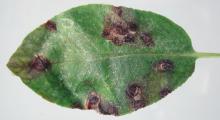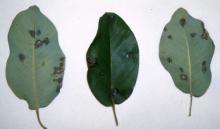See:
Crabapple (Malus spp.) - Twig Dieback and Canker
Cause More than a dozen fungal organisms can cause leaf spots and dead regions on madrone leaves, and the specific disease can be difficult to identify. For all these foliage diseases; however, airborne or water-splashed spores infect young leaves during wet weather, often in spring. Trees growing in creek bottoms, valleys, and the forest understory are most likely to be infected. Leaf blight severity has been observed to increase when growing in wetter, cooler conditions such as northwest WA. Seed sources from southern districts grown in northern areas also experience higher leaf blight severity.
Ruptoseptoria unedonis (formerly Mycosphaerella arbuticola), has been found by the OSU Plant Clinic. This fungus also causes a leaf spot on the related strawberry tree (Arbutus unedo). Tar spot, caused by Rhytisma arbuti has been reported from Washington. These diseases may result in unsightly foliage but seldom are serious alone.
Numerous madrones in the PNW experienced severe leaf blight during the winters 2009 and 2010. The fungus Phacidiopycnis washingtonensis has been isolated regularly from this blighted tissue and has been shown to colonize cold damaged leaf tissue. It can also infect leaves directly that have not been cold damaged. Other hosts include crabapple where it causes a twig dieback and canker and on apple where it is a post-harvest storage rot problem.
Leaf spots generally increase on madrone leaves as the year progresses, especially during the winter in high rainfall areas. Leaves are naturally shed by the mid-summer over a year after they develop. Leaf spots are a problem if they cause defoliation before that time.
Symptoms Mycosphaerella-affected leaves have numerous small spots, 0.25 to 0.5 inch in diameter. On the upper leaf surface, spots are circular to irregular in shape, with grayish centers and distinct, purplish brown margins. On the lower leaf surface, spots are light brown with darker brown margins. Centers of spots may contain small black dots (pseudothecia), which are the spore-containing fruiting bodies of the fungus. Defoliation may occur.
Tar spot, produces irregularly shaped, black, tarlike spots on the undersides of leaves. Leaf tissue around the spots becomes yellowish.
Phacidiopycnis leaf blight - Necrotic spots anywhere on the leaf and blotches along edges and tips of leaves.
Cultural control
- Rake up and destroy fallen leaves.
- Reducing the competition for sunlight will aid madrones and increase air circulation keeping the environment dryer.
- Select trees from northern seed sources.
References Bennett, M. and Shaw, D. 2008. Diseases and insect pests of Pacific madrone. OSU Extension Service EC 1619-E.
DeWald, L.E., Elliott, M., Sniezko, R. and Chastagner, G.A. 2020. Geographic and Local Genetic Variation in Pacific Madrone Leaf Blight. In: Publication: Gen. Tech. Rep. SRS-252. Asheville, NC: US Department of Agriculture Forest Service. Southern Research Station, pp.132-136.
Sikdar, P., Mazzola, M., and Xiao, C.L. 2019. Genetic and Pathogenic Characterization of Phacidiopycnis washingtonensis from Apple and Pacific Madrone from the Western United States. Phytopathology 109:469-479.





